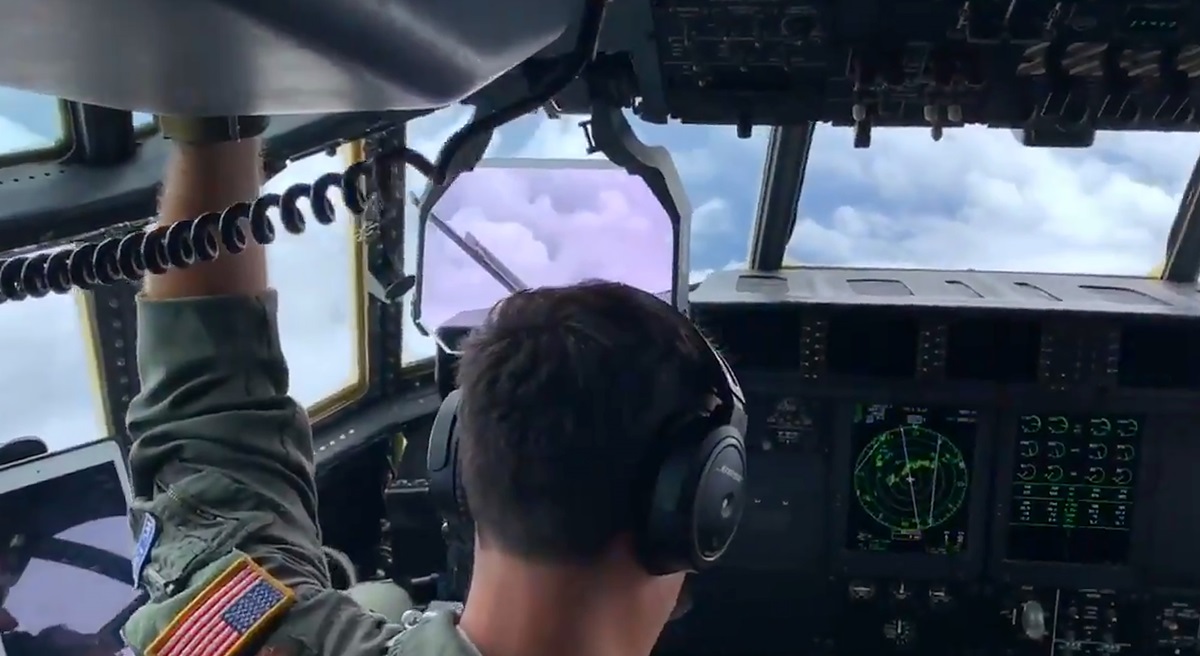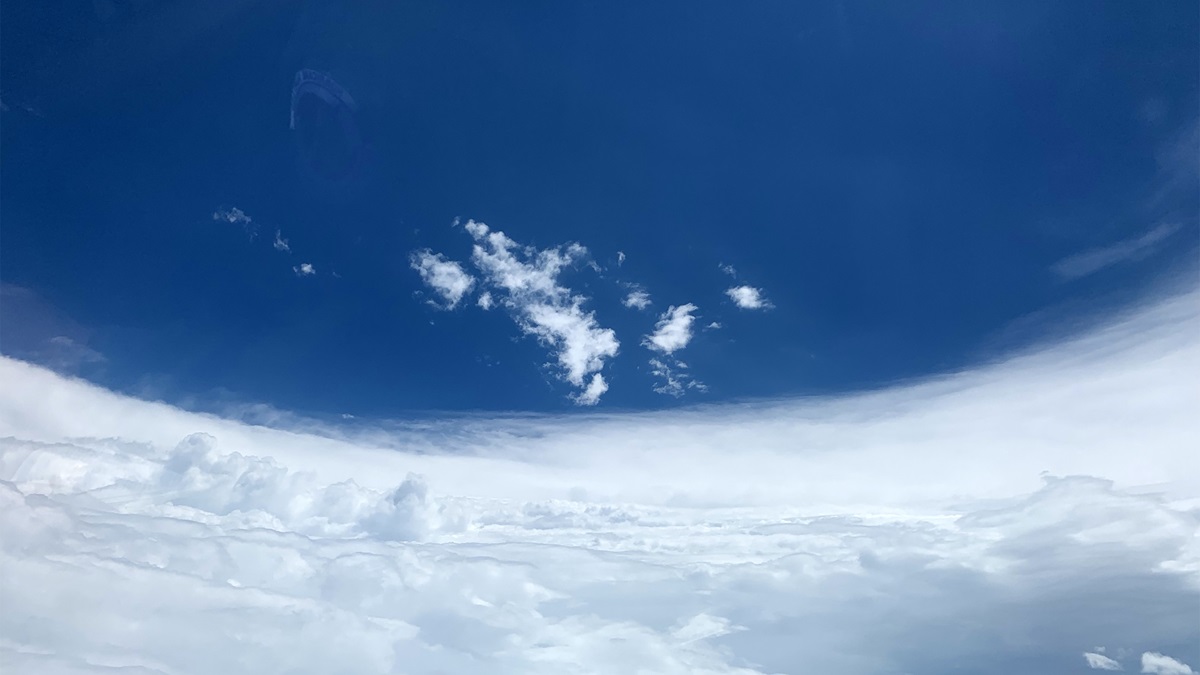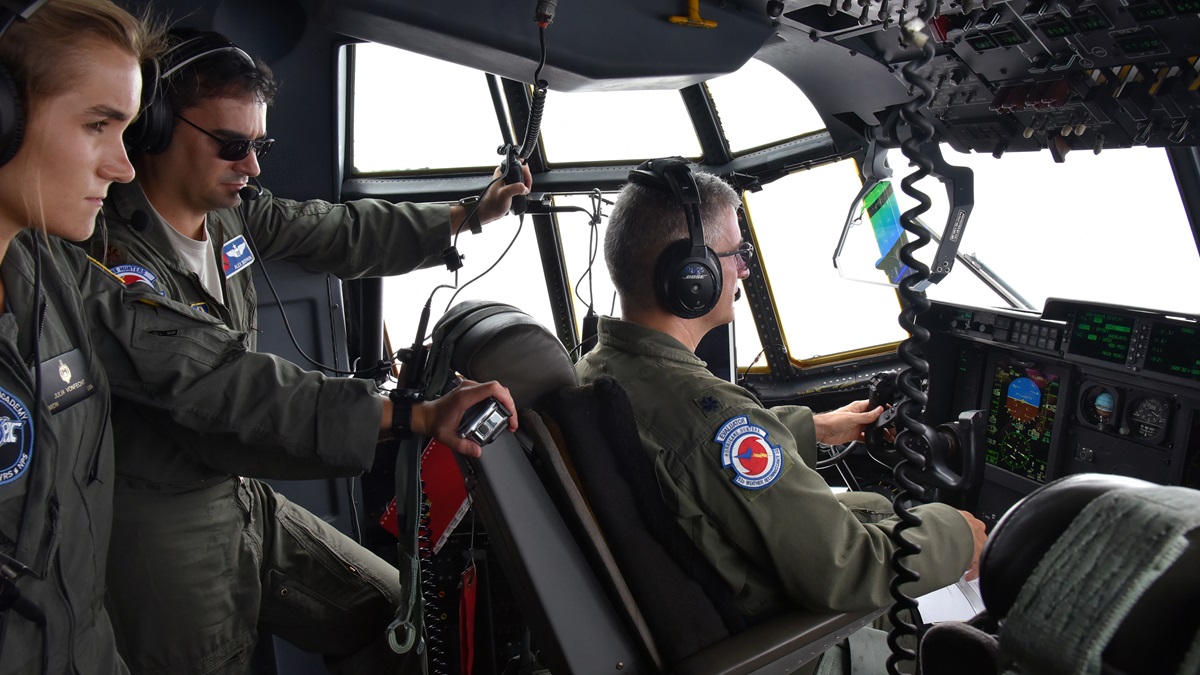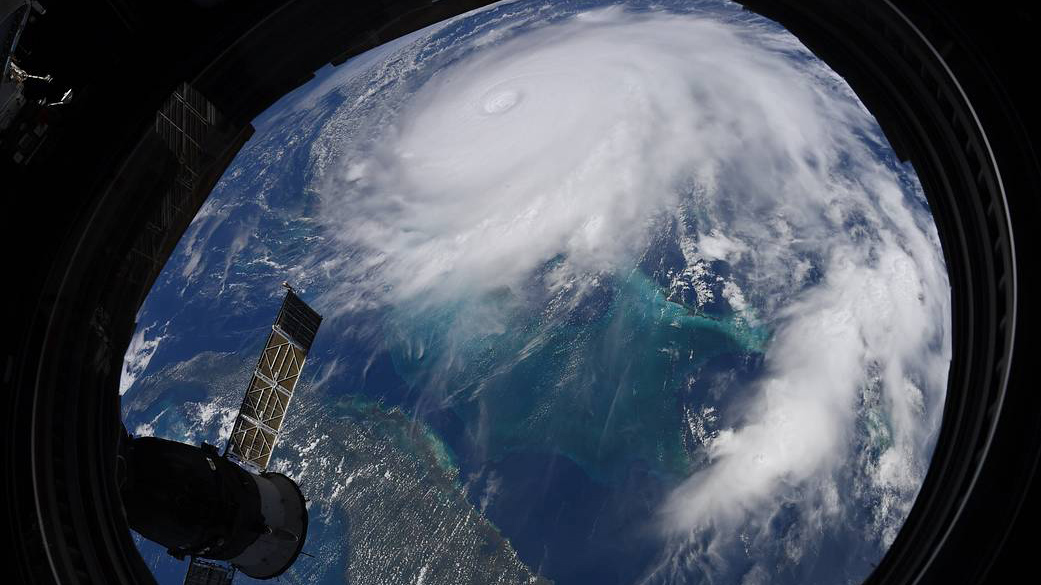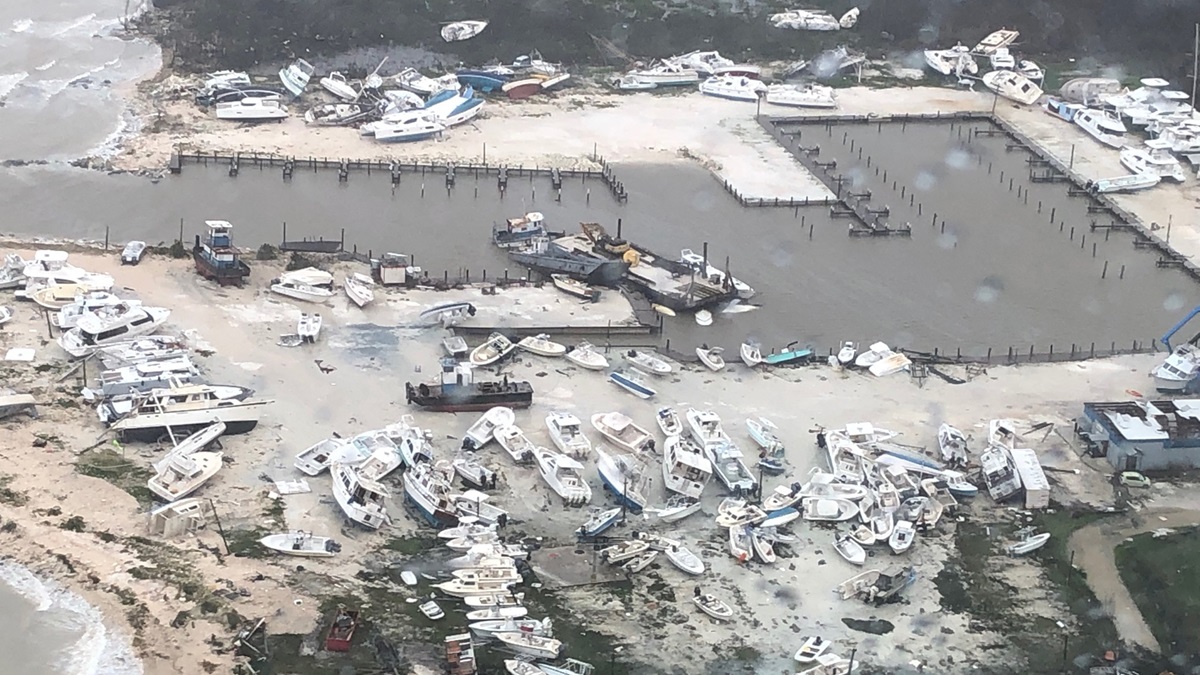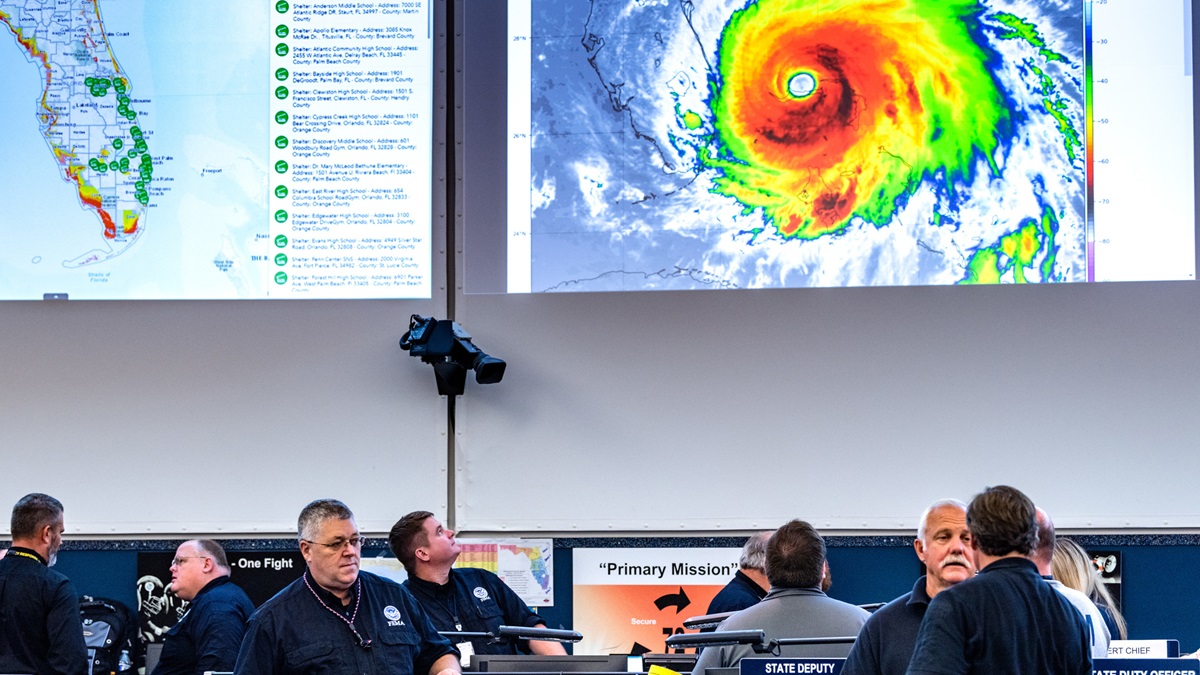Hurricane Dorian GA relief efforts for Bahamas underway
Don’t go (alone), dire need for donations
Hurricane Dorian made landfall on the North Carolina coast as a Category 1 storm Sept. 6 after whipping the Bahamas with wind gusts clocked at 185 mph that turned the island paradise into a disaster zone, killing at least 43. “General aviation is poised to do the best it can to help Bahamians recover from this disaster,” said AOPA President Mark Baker who traveled to Florida to liaison with officials as island airports began to open.
The hurricane came ashore at Cape Hatteras, North Carolina, Sept. 6 with sustained winds of 90 mph after slamming the Bahamas with double that velocity and causing nearly “total destruction” before bearing down on the United States. GA pilots with a big heart were quick to respond with offers to deliver supplies and to assist recovery efforts after the Category 5 tempest. Officials suggested exercising caution to make sure recovery efforts were safe and orderly.
Pilots reaching out
AOPA leadership is working with federal, state, and local authorities in the U.S. and the Bahamas to facilitate the delivery of urgently needed emergency supplies, and to support the long-term recovery of the islands that were devastated by Hurricane Dorian.
Baker and Senior Vice President of Media, Communications, and Outreach Tom Haines canceled all plans and began coordinating communications among GA relief organizations and government entities to assist the devastated islands.
AOPA has a long history of working with the Bahamian government and its people; our members, collectively, operate thousands of airplanes and helicopters, and many of us have visited the Bahamas in better times and forged lifelong friendships there. Our hearts go out to our friends, and we want very much to help.
Our members up and down the East Coast and beyond are ready to supplement the airlift capacity of the relief effort in the coming days, as well as the months and years ahead. AOPA also has longstanding relationships with the many nonprofit aviation groups that specialize in leveraging aircraft in numbers to support disaster recovery, and we are eager to do what we can to facilitate the collective response and rise to meet the tremendous needs of the Bahamian people, both now and in the future. We are in this for the long haul.
Baker said, “The number one thing you can do right now is to start donating to relief groups that are going to be in the area” to fuel their efforts to rebuild. He added that rebuilding would be “a complicated relief effort” because of the number of boats, aircraft, military traffic, and two governments involved in the process. He acknowledged there would likely be frustration as efforts ramp up and asked for patience. “We are going to try and work this thing through as best as we can and as fast as we can.”
Haines, who was in Nassau, said the devastation in the Bahamas was “much worse than when we helped in 2017” with GA aircraft caravans that brought much needed supplies to Florida and the Caribbean islands after Hurricanes Irma and Maria. He added that AOPA leadership is helping coordinate communication among some of the federal agencies in the Bahamas and in the U.S., and among the groups of relief organizations scrambling to help.
“One of the best ways to help is for GA pilots to donate to relief organizations that are already in the area,” including AERObridge, Operation Airdrop, and others “that are skilled in these types of recovery efforts,” he added. “It’s going to be a massive effort” to rebuild after nearly “total devastation on some of the islands.”
Donations/relief
Donating to relief efforts
“Please donate the necessary requested items to help the citizens of the Bahamas and the eastern coast from the devastation of Hurricane Dorian,” requests Florida Field Director of Emergency Services Charley Valera.
Donations will be accepted at Fort Lauderdale Executive Airport beginning Sept. 5. Suggested donations include bottled water, canned food with flip-top lids, pet food, diapers, baby food/formula, medical supplies, flashlights, and batteries. Call 517-740-7083 for more information.
Click here for a list of organizations accepting donations to help those affected by Hurricane Dorian.
AEROBridge activating for Hurricane Dorian
AERObridge, the organization founded to muster GA pilots and aircraft to fly relief supplies after Hurricane Katrina, spread the word on Facebook that pilots and aircraft were being called on once again.
The group began activating flight missions Sept. 5 after the immediate danger to the Bahamas dissipated. The organization asked for pilots to shuttle supplies in Florida from Ocala International-Jim Taylor Field to Fort Lauderdale Executive Airport. The group also requested “turbine powered longer range aircraft” to fly from Ocala to Treasure Cay, Bahamas. Other flights based from South Florida were also expected, the group wrote on Facebook.
Organizers previously urged caution until conditions were safe for volunteers to deploy. Meanwhile, pilots willing to volunteer to fly relief supplies into the Bahamas, as well as the Southeastern U.S., if needed, were asked to register on the group’s website and await further instructions.
“We also have a new system to which we dispatch, record, and track missions, so it is important to register for access to the new system," AERObridge National Chapter Coordinator Trevor Norman wrote in an email. “Even if you registered with AERObridge previously, this (is a) new system and requires new registration for access to the mission board.”
AOPA members have answered this call before, and the association has contributed to various AERObridge-organized disaster recovery and relief missions in years past, such as supporting South Carolina in the wake of Hurricane Joaquin in 2015. AERObridge pilots delivered supplies to Texas following Hurricane Harvey in 2017, coordinating with other nonprofit groups and government agencies to muster pilots, who in some cases rounded up donated supplies in their local communities and flew them to where they were needed.
Air Serv ready to help
Danielle Payant of Air Serv, a nongovernmental agency that specializes in worldwide disaster relief and long-term recovery and sustainability, said Sept. 9 the organization was eager to “offer assistance without contributing to the chaos” that generally follows a natural disaster. "We know there are a lot of individuals that want to help deliver medicine, supplies, or personnel,” said Payant. She suggested pilots contact her directly via email or telephone 703-328-5551 to discuss options for coordinating relief. The humanitarian relief specialist has 35 years of experience matching pilots and aircraft to a community’s needs. “We can put somebody in Florida or Nassau to work with individual pilots and NGOs,” rather than adding to the workload of “overwhelmed” local air traffic controllers, she said.
'Big Easy' sends help
New Orleans-based entrepreneur and Bahamas developer Sidney Torres of IV Waste is sending two Douglas DC–3 cargo aircraft stuffed full of medical supplies and food to the stricken islands. Torres told WWLTV that the aircraft would drop off 20,000 pre-packaged meals that could feed a family of four for up to four days. "Anything you can do is a huge help," he told the TV station. New Orleans experienced the catastrophic effects of Hurricane Katrina in 2005.
Sun 'n Fun serves as relief operations center
The Sun’n Fun campus at Lakeland Linder International Airport will begin receiving nonperishable supplies Friday, Sept. 6 at 9 a.m. for distribution. Those wanting to contribute may drop off at Hangar C on the campus, or ship to:
Sun ’n Fun Fly-In
Attn: Bahamas Relief
4175 Medulla Rd
Lakeland, FL 33811
The airport and Sun ‘n Fun staff and local volunteers planned to reprise their roles from Hurricanes Irma and Maria, with the organization serving as a center for relief flight operations to the Bahamas and elsewhere. Greg Gibson, Chief Marketing Officer and Director of Air Operations for Sun ‘n Fun, wrote in an email that the organization was “ready to assist with flight operation facilitation once the Bahamas are ready to manage the flights.”
Airport operations staff will manage the arrivals and departures of volunteer pilots while Sun ‘n Fun staff and volunteers coordinate hangar and ground operations. “We plan to continue taking supplies for several weeks,” he added. U.S. Customs and Border Protection representatives will also be ready to expedite Customs processing from the airfield.
All inquiries regarding flight operations and services should be directed to Lakeland Linder Air Operations at 863-834-4911 or via email. Aircraft are requested to obtain arrival instructions from the Lakeland airport prior to departing their home field.
Donations accepted at Signature FBOs
Signature Flight Support fixed-base operations in Florida are accepting relief supplies for the Bahamas. Mike French, the firm's regional vice president, said staff will move donated items to West Palm Beach International Airport where they can be shipped by air to the Bahamas.
If pilots with experience flying into and out of the Bahamas wish to carry supplies from Palm Beach, or any Florida airport where Signature has a presence, they may coordinate with Signature's Christine Rosensteel by calling her at 561-478-8700, or by working with the manager of their local Signature FBO.
Seaplane pilots reach out
The Seaplane Pilots Association sent an email to its members alerting them of a partnership with Tropic Ocean Airways to “deliver much-needed aid to our island friends who have experienced one of the worst hurricanes in history.”
The Fort Lauderdale, Florida-based aviation charter company is accepting supplies including water, food, medicine, chain saws, generators, and other goods.
The seaplane pilots group added that material donations for what would likely become “a long-term relief effort” could also be dropped off at Brown's Seaplane Base in Winter Haven, Florida.
Operation Airdrop prepares measured response
Operation Airdrop, which delivered more than 280,000 pounds of supplies during 475 flights after Hurricane Florence swept through the Carolinas in 2018, made contacts up and down the East Coast in advance of the storm's expected U.S. mainland landfall.
The grassroots group of GA pilots and volunteers noted on social media that a long-planned safety seminar was underway to coach pilots on “everything from making sure maintenance is up to date, to securing loads, to the actual flying, and unloading of the airplane.” Many of the safety guidelines were drawn by Guy Maher, a pilot and an Operation Airdrop volunteer who assisted during Hurricane Florence recovery efforts.
Organizers noted that while the "devastation of Abacos and the Grand Bahamas is difficult to digest, and only fuels our intense desire to help," the group's response would be measured. The risks of flying open-water legs in small aircraft with limited payloads, runway conditions, fuel availability, legal requirements, and mission scope were key factors. However, the group welcomed assistance from pilots with "high performance single, twin, and/or turbine aircraft with a minimum payload (taking into consideration the need to carry fuel for the entire round-trip plus reserves) of 700 pounds" and those with "extensive experience flying in the Bahamas."
On Sept. 4 the group continued to urge caution during an appeal that emphasized safety for those pilots considering the open-water legs to the Bahamas. “We have to be absolutely certain we are sending our volunteer pilots and the goods they carry into conditions that are safe, secure, and that ensure that your donations will get to where they need to be. Unfortunately, we are not able to guarantee that at this time.”
As cruise ships began to arrive with medical attention, supplies, and other necessities Sept. 6, Operation Airdrop leadership alerted members that the organization was "officially standing down Bahamas relief operations." The group thanked pilots and other volunteers for opening their hearts early and often, and noted that it was still keeping an eye on the Carolinas for potential flooding.
Operation 300
Florida-based Operation 300 has set up a dedicated account to receive tax-deductible funds, which will be used to purchase supplies, jet fuel, and whatever else is needed during this effort. One hundred percent of these funds will go to aid the people of the Bahamas, in particular the outer islands including Green Turtle Cay, Guana Cay, Hopetown, Man-O-War Cay, and Elbow Cay.
The group is also accepting donations of supplies and food at Stuart, Florida’s Witham Field at 1845 SE Airport Rd., Hangar 3.
Once the trucks are filled, the items will be transported to private airplanes and boats that are suited and approved for delivery to the islands.
Items needed include toiletries, diapers, clothing, trash bags, tarps, first aid kits, nonperishable foods, flashlights, chainsaws, gloves, extension cords, generators (new in box), water, and other necessities. Operation 300 is also working with local food distributors to be able to purchase food items at wholesale.
NBAA posts HERO database reminder
The National Business Aviation Association posted a reminder for business pilots to review information posted on the organization’s Humanitarian Emergency Response Operator site.
CAP on standby
The Civil Air Patrol was preparing aircraft, volunteers, and cadets “for the possibility of extended missions in southern states once Hurricane Dorian makes landfall,” the group posted on its news site. The U.S. Air Force auxiliary owns and operates a large fleet of GA aircraft and unmanned aircraft, and counts 10,000 volunteer members serving in Florida, Georgia, Alabama, Tennessee, Mississippi, Puerto Rico and the U.S. Virgin Islands.
Madea star to Abaco Islands
Atlanta-based movie mogul Tyler Perry has offered one of the actor’s personal aircraft to the relief efforts underway in the Bahamas, the entertainment news site TMZ reported. Perry, known for his roles in the Madea comedies, loaded up a seaplane with supplies including “much-needed water, juice, sleeping bags, diapers, various hygiene products and a lot of other basic necessities ” bound for the Abaco Islands and made two trips Sept. 5.
Lucacris service day
Hip-hop star Ludacris pledged to donate all of the proceeds from his annual LudaDay Weekend event dedicated to social service to helping the hurricane relief fund. He raised more than $100,000 over the weekend and announced the gift via social media, CNBC reported.
Disney pledges $1 million for relief
The Walt Disney Company, which operates theme parks across the globe—including Disney Castaway Cay in the Bahamas, pledged a $1 million donation to nonprofits, plus “the provision of supplies—including food staples and basic construction materials—to those in impacted areas.”
Cruise ships steaming to help
“In the wake of Dorian, we’re mobilizing our fleet to help those who need it,” the Royal Caribbean Cruise Line announced via social media. “In partnership with the Bahamian government & The Bahamas Feeding Network tomorrow we’ll deliver +43k water bottles, 10k meals, generators, supplies & we’re just getting started.”
Other cruise lines followed suit. Carnival Corporation’s Carnival Foundation pledged $2 million. Norwegian Cruise Line planned to deliver relief supplies "donated by Norwegian Cruise Line and the City of Miami,” and added a $1 million donation to the All Hands and Hearts nonprofit.
Pilot procedures
'Don't go on your own'
“Don’t go on your own” is the message the AOPA Pilot Information Center is stressing to members who want to help in the devastated paradise that may be their second home or a frequent fly-out.
“Everything that is normal is no longer normal,” said Tom Zecha, senior manager of the PIC. First, there is no place to land. Bahamian sources say only that Sandy Point is open. Second, flying is only permitted above 5,000 feet as military, government, and research aircraft have priority access. Third, there is no fuel; the barge that is en route has only automobile gas and Jet A.
“We know you want to help from the kindness of your heart, but it can backfire,” Zecha said. “Our legal team wants you to be careful and consider other ways to help.” Pilots seeking further information can call 800-872-2672.
Pilots with mission-capable aircraft, permission, and experience should be especially wary of GA processes, U.S. Customs and Border Protection procedures, and air traffic control regulations—which could change during the fluid and rapidly evolving situation. Make sure to coordinate all humanitarian flights through established charitable flying organizations that are working directly with government agencies.
Air traffic control
The FAA Air Traffic Control System Command Center is involved at a strategic level, and local ATC facilities provide additional airspace services.
The Miami Air Route Traffic Control Center handles air traffic at higher altitudes and airspace between airports within the Bahamas at lower altitudes, explained Jim Coon, AOPA senior vice president of government affairs and advocacy. Air traffic controllers from the Bahamas handle local and some low-level airspace control.
In addition, the islands are experiencing numerous radio and radar outages that are affecting local airspace and airports.
Notices to airmen related to the hurricane’s aftermath are posted, and they are the best source of information regarding airport and navigational aid status. For additional information pilots can contact the U.S. national airspace system operations center at 540-359-3110.
Bahamas airport conditions
The Grand Bahama International Airport: The Freeport, Bahamas, airfield suffered severe damage to building structures and to aircraft based on the field but the airport was open as of Sept. 6. Local pilots confirmed the facility’s runway did not appear to be damaged despite news reports claiming otherwise but they urged caution because of storm debris on ramps and other areas.
West End Airport: The private airport at the western tip of Grand Bahama Island was open as of Sept. 6. The AOPA Bahamas Guide notes there are no services. at this airfield.
Treasure Cay International Airport: The area around the Abacos Islands airport about 25 miles north of Marsh Harbor was flooded, according to local sources, but the airport was preparing to accept aircraft as of Sept. 6.
Leonard M Thompson International Airport: The area around Marsh Harbor appeared to be some of the hardest hit when Hurricane Dorian made landfall in the Bahamas Sept. 1. The airport located in the center of the island was preparing to accept aircraft as of Sept. 6.
Sandy Point Airport: The remote airfield at the southwestern tip of The Abacos was preparing to accept aircraft as of Sept. 6.
Pilot group posts updates
A pilot-sourced page posted by Mark Zee of OPSGROUP is providing island updates gleaned from local sources. Zee wrote that his group was “continually updating" the tracker and the briefing pages with new info and he urged fellow pilots to contact him with additional info.
Compliance and charitable flights
After natural disasters, such as Hurricane Dorian, many pilots think about how their unique skills can be used to help. AOPA recently published a detailed article on this topic, and here are some key takeaways.
FAA rules apply. FAA authority applies to N-numbered aircraft, even when they are flown outside the U.S. (for example, in the Bahamas to help in the aftermath of Hurricane Dorian).
Pilots must pay for all costs of their flights and cannot accept reimbursement from any third parties. There are only two exceptions to this rule, which apply to pilots flying:
- for the Civil Air Patrol or
- under a petition for exemption granted to a charitable flying organization allowing fuel cost reimbursement for charitable medical flights, subject to onerous conditions and limitations.
Organizations with current exemptions are: Vital Flight, Inc.; Airlift Hope of America; Mercy Medical Airlift; Angel Flight Mid-Atlantic; Vet Air Inc.; and Angel Flight of New England, Inc. These exemptions are not valid for operations outside the U.S.
Pro rata cost sharing is not allowed. The FAA has issued a legal interpretation declining to find a “common purpose” for charitable transportation of persons and prohibiting cost sharing for such flights.
AOPA has online information for pilots who want to fly for charity. The AOPA Air Safety Institute's "Public Benefit Flying: Balancing Safety and Compassion" Safety Advisor is an excellent resource for pilots.
Here are some additional tips:
- Verify your insurance coverage. Pilots who wish to perform charitable flights should check their policy or with their insurance broker. For example, some insurance policies do not cover international flights or require a rider to provide liability insurance coverage.
- Verify current restrictions and rules, especially for international flights. Temporary flight restrictions and availability of air traffic resources change rapidly after natural disasters, so don’t be caught unaware. If you’re flying internationally, don’t forget CBP and eAPIS requirements, which could be challenging if you are transporting individuals who have lost their identification documents.
Finally, only fly charitable flights through a coordinated effort, not on your own.
Special services
Signature Aviation at North Palm Beach County General Aviation Airport is waiving all fees and offering fuel for cost to pilots flying relief missions to the Bahamas.
Official word
Flight restrictions posted for Bahamas, Carolinas
There is a specific notice to airmen and distinct routes that pilots should utilize provided they have prior approval and the resources to undertake such missions. Pilots should call 904-480-3162 or 561-571-2541 during daylight hours for updated aviation information and questions regarding flight routes.
Temporary flight restrictions have been posted for the Bahamas as Hurricane Dorian cleanup efforts begin. The restriction noted that unless U.S. certificated airmen and civilian aircraft “have been granted permission in advance by the Commonwealth of the Bahamas,” they are “prohibited to enter Nassau flight information region.”
A frequently asked questions page for pilots traveling to the Bahamas contains additional information.
In the U.S., caution was urged for pilots along the northeast coasts of Florida, Georgia, and the Carolinas. Air coordination areas were in place for disaster response and recovery flights “to support a safe environment for aviation operations.” The FAA noted that pilots should expect TFRs when deemed necessary.
Bahamas aviation relief form posted
Pilots on Hurricane Dorian relief missions with permission from the Bahamas Civil Aviation Authority can download, print, and keep with them a temporary flight authorization form.
Fees waived for relief flights to Bahamas
The Acting Minister of Finance for the Bahamas said the islands' emergency necessitated tariff exclusions for relief missions to assist those "who have suffered hardship or loss as a result of Hurricane Dorian." The government waived departure taxes, customs duties, and other fees for noncommercial flights through Dec. 2 as the island's residents rebuild after the powerful storm's 20-foot storm surge and devastating winds. Pilots flying into the area can prepare for their relief flights by downloading, printing, and carrying with them the special exclusion document.
Special notes
U.S. Customs and Border Protection officials reminded pilots that Bahamians should not be brought to the U.S. unless they need urgent medical attention. Most should instead be evacuated to Nassau. In addition, pilots transporting individuals to the U.S. should make sure to completely fill out an eAPIS form and file it with authorities as soon as possible before departing to the U.S.
North Carolina
In the hours before the storm made landfall at Cape Hatteras on the Outer Banks, Gov. Roy Cooper alerted residents to persevere and to stay safe. “As #HurricaneDorian thrashes the North Carolina coast, Gov. Cooper had one message to the team working in the Emergency Operations Center tonight: ‘Let's get the job done,’” the governor posted on social media.
South Carolina
Gov. Henry McMaster is holding daily briefings updating residents on current conditions, relief centers, and ways to help.
Maryland
Maryland Gov. Larry Hogan offered help to North Carolina residents to assist in potential rescues from the effects of Hurricane Dorian. The governor’s office posted on social media that members of the Maryland National Guard’s Helicopter Aquatic Rescue Team were ready to assist during potential rescue operations. The office was also “in contact with North Carolina Governor Roy Cooper, as well as South Carolina Governor Henry McMaster and Governor of Virginia Ralph Northam, to offer any support and assistance we can provide.”
Virginia
Gov. Ralph Northam urged residents to finish preparations as the storm approached Sept. 5. “Now is the time for Virginians to finalize their preparations ahead of#HurricaneDorian,” he wrote on social media. “Much of eastern Virginia should expect tropical storm force winds, storm surge, heavy rains, and flooding overnight and tomorrow. Be alert and stay safe.”
Tracking Dorian
A hurricane of historic proportions
Stinging bands of rain, tornadoes, and high tides pounded North Carolina's Outer Banks before Hurricane Dorian made landfall at Cape Hatteras as a Category 1 storm Sept. 6.
A storm surge of more than seven feet swept over the state's Ocracoke Island following more than 6.5 inches of rain, UPI reported Sept. 7.
The storm, which hovered between a Category 3 and Category 2 system as it approached the U.S. mainland, had killed at least 43 people as it raged through the Bahamas, noted Bahamas Minister of Health Duane Sands. Hundreds were still missing and "around 70,000 people" were in need of assistance six days after 185 mph winds caused catastrophic damage Sept.1.
The storm was so powerful that Dorian maintained hurricane status as it swept past the New England coast Sept. 7. It slammed into Canada Sept. 8 as a post-tropical cyclone with 100 mph winds, marking the epic tempest's fifth landfall, USA Today reported.
U.S. Air Force Reserve “Hurricane Hunter” specialists from the 53rd Weather Reconnaissance Squadron and the National Oceanic and Atmospheric Administration pierced Hurricane Dorian’s eyewall numerous times Sept. 4 and continually relayed life-saving information as the storm targeted the East Coast.
Earlier, Air Force Reserve pilot Lt. Col. Jeff Ragusa, based at Keesler Air Force Base, Mississippi, pointed a modified Lockheed Hercules WC–130-J model at the storm’s center as it ravaged the Bahamas with winds clocked at 185 mph and gusting to 220 mph at Elbow Cay, Abacos, while GA pilots in the U.S. mobilized for relief efforts.
The stout, four-engine aircraft is outfitted with external fuel tanks to permit 14-hour flights. Criss-cross flight patterns allowed crewmembers to drop numerous GPS sensors into the hurricane’s eye and its edge and to record the storm’s direction, speed of movement, and wind speed. The measurements were critical to safety for an estimated 25 million people potentially in its pathway along the East Coast of the U.S., CBS News reported.
Meanwhile, NOAA aircraft based in Lakeland, Florida, flew multiple flights in two Lockheed WP–3D Orion four-engine turboprop aircraft named Kermit and Miss Piggy that are outfitted with sophisticated weather reporting equipment. One of the aircraft can be spotted on a screen capture from FlightAware.com while numerous other airplanes, including a fleet of training aircraft from Embry-Riddle Aeronautical University, fled the state to safer locations.
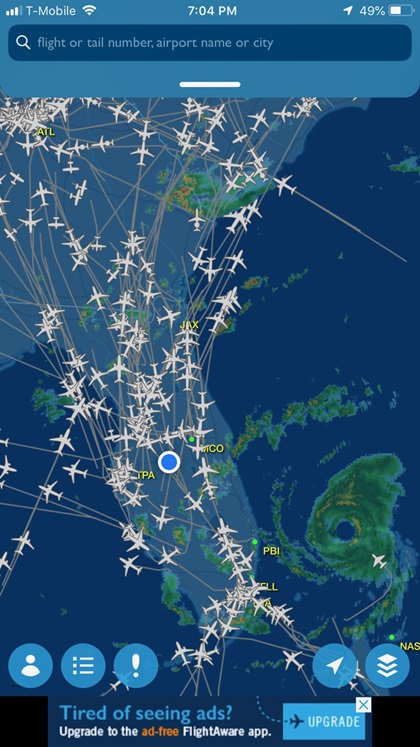
A Gulfstream IV–SP twin-engine research jet performed high-altitude reconnaissance to further hurricane forecasting models. The aircraft drops measuring devices called dropsondes, which report the pressure, temperature, humidity, and GPS Doppler frequency shifts as the devices descend to earth. The Doppler shifts are used to compute the horizontal and vertical wind components, NOAA noted. A tail-mounted Doppler radar unit analyzes a storm’s structure to determine intensity. The crew, the aircraft, and the devices work together to enhance hurricane modeling, forecasting, and safety precautions.
Thirteen missions were flown by crews in the Lockheed WP–3D and 10 missions were completed by crews in the high-altitude Gulfstream IV–SP, through Sept. 4, with no end in sight. Weather researchers at the group's headquarters tweeted a zigzag graphic of their flight paths noting "incredible work by @NOAA_HurrHunter flight crews!"
Forecast to maintain hurricane strength for several more days, the storm slowed to an excruciating crawl as it lashed the northwestern islands of the 700-island archipelago. The National Hurricane Center in Miami predicted Sept. 3 that Dorian would turn north and skirt the coasts of Florida, Georgia, South Carolina, and North Carolina before weakening to tropical storm strength and brushing past the Northeast coast. Though the storm’s center was expected to remain miles from shore, hurricane warnings were posted Sept. 1 along much of Florida’s Atlantic coast, and were extended through the Carolinas by Sept. 5. "Life-threatening storm surge and dangerous winds" were predicted to continue along portions of the North Carolina coast and through southeast Virginia, the National Weather Service warned Sept. 6 after the storm's North Carolina landfall.
The National Weather Service also kept an eye on Tropical Storm Gabrielle, which formed Sept. 4 in the eastern Atlantic, and on Tropical Storm Fernand, which earlier threatened the east coast of Mexico.




